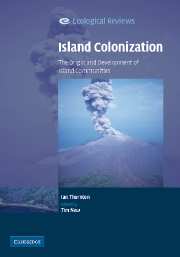PART III - The recolonization of devastated islands
Published online by Cambridge University Press: 12 January 2010
Summary
Islands as areas for the study of community assembly
Compared with theoretical or laboratory studies on community assembly, studies of natural microcosms such as tree holes, or studies of the recovery of devastated continental areas, studies of the rebuilding of true island biotas on a macro-scale have both advantages and disadvantages.
Island studies are often more informative than studies of the recovery of continental areas simply because the devastated area is clearly defined and separated from its source, so that colonizing organisms can usually be clearly identified as such, and not confused with transients. Moreover, the encircling barrier reduces the likelihood of a ‘rescue effect’ (declining populations being ‘rescued’ from extinction by infusions of individuals from populations outside the area in question), thus allowing extinctions to occur and to be recognized. With both immigrants and extinctions clearly identifiable, turnover rates can be estimated, at least in theory, with some precision.
The most obvious disadvantage of such studies is that they are seldom possible. Destruction of an island's biota followed by natural reassembly is a rare occurrence, and if such natural experiments are to be exploited fully by scientists they must be recognized and acted upon quickly. The rarity of such events means that each must be analysed and studied; scientists cannot afford to let one pass unstudied. Each is fundamentally one of a small number of parallel ‘replicate’ natural experiments with considerable importance in helping to develop any general picture that exists.
- Type
- Chapter
- Information
- Island ColonizationThe Origin and Development of Island Communities, pp. 57 - 60Publisher: Cambridge University PressPrint publication year: 2007



